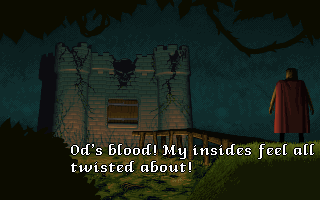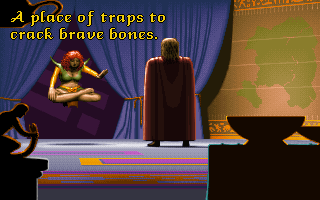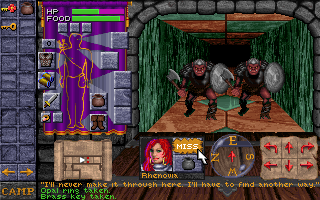Retro Replay Review
Gameplay
Dungeon Hack marries the deep, grid-based exploration of traditional roguelikes with the first-person party mechanics of the Eye of the Beholder engine. At its core you’ll find the familiar mechanics of Hack and NetHack—permanent death, inventory juggling, and unpredictable encounters—wrapped in a graphical, real-time format. The game’s signature feature is its dungeon generator: you can customize the overall layout, room density, theme, monster frequency, trap frequency, and even the types of treasure you’ll find.
(HEY YOU!! We hope you enjoy! We try not to run ads. So basically, this is a very expensive hobby running this site. Please consider joining us for updates, forums, and more. Network w/ us to make some cash or friends while retro gaming, and you can win some free retro games for posting. Okay, carry on 👍)
Before each run you adjust sliders and toggles to sculpt your ideal challenge. Want a gauntlet dominated by fire traps and salamanders? Crank up the trap and elementalist frequencies. Looking for an epic haul of magic items and treasure rooms? Increase item density and treasure quality. Every tweak yields a fresh dungeon, making each playthrough feel like a unique campaign. The interface is straightforward yet surprisingly deep, offering a level of customization rarely seen in mid-’90s CRPGs.
Combat unfolds in real time along the classic grid, blending strategic positioning with party-based tactics. You’ll issue orders to each character—fighter, cleric, mage, thief—and watch them hack, slash, and cast spells. The permadeath option adds real stakes: when your entire party falls, that character and all saved games vanish, driving every decision to feel consequential. This high-risk, high-reward setup will appeal to seasoned dungeon crawlers craving a brutal but fair challenge.
Graphics
The Eye of the Beholder III engine delivers moody, drab corridors lit by torches and littered with cobwebs. Walls bear mossy textures, and floors crack with age, giving each level a dank, oppressive atmosphere. Though the palette leans heavily on browns and grays, occasional bursts of color—from glowing runes to acid-spitting traps—break the monotony and keep your eyes peeled for danger.
Monster sprites range from inch-worm slimes to hulking ogres and spectral undead. While some animations feel simplistic by today’s standards, they effectively convey each creature’s threat level. Spell effects—fireballs, lightning bolts, and acid sprays—flash vividly against the environment, ensuring that your party’s magical arsenal is as satisfying to wield as it is deadly to behold.
The UI overlays are clean and unobtrusive. Health bars, spell icons, and inventory panels slide seamlessly into view without obscuring the action. Load times are minimal, even on higher dungeon settings, and the game rarely stutters during intense encounters. In short, Dungeon Hack’s graphics may show their age, but they still deliver an immersive dungeon-delving experience.
Story
Dungeon Hack is light on a traditional narrative, but that’s by design. There’s no sprawling epic or scripted cutscenes—instead, the story emerges organically as you delve deeper into randomized depths. Each dungeon theme (mage’s tomb, goblin warrens, fungal caverns) comes with its own flavor text and environmental cues, inviting you to piece together a loose narrative of what befell the previous inhabitants.
Every playthrough tells a different tale of discovery and survival. Did you find a hidden shrine to a forgotten deity? Uncovered a cursed artifact that turned your tank into a gremlin? Or did the shifting walls nearly trap you forever? These emergent moments become your personal legend, replacing a set storyline with a tapestry of player-crafted anecdotes.
For those craving a stronger plot, Dungeon Hack encourages you to provide your own context. You could frame your dungeon crawls as the trial chambers of an arcane guild, the lost mines of a dwarven kingdom, or the prison levels beneath an ancient wizard’s tower. The sparse narrative is both a limitation and an invitation—allowing creative players to overlay their own mythos onto the randomly generated depths.
Overall Experience
Dungeon Hack excels at what it sets out to do: deliver a highly customizable, first-person roguelike that rewards experimentation and punishes overconfidence. The sheer number of dungeon permutations (over four billion possible combinations) ensures near-infinite replayability, and the permadeath feature keeps every decision tense and meaningful. If you love tweaking parameters and then braving an ever-changing labyrinth, this title will keep you hooked for hours on end.
However, the game isn’t without rough edges. The repetitive environment textures can blend together after dozens of hours, and the lack of an overarching storyline may leave some players craving more narrative depth. Combat, while engaging, can feel grindy during extended sessions, especially when low-level monsters swarm in endless waves. Patience and a willingness to embrace the roguelike ethos are key to enjoying Dungeon Hack at its best.
Ultimately, Dungeon Hack is a niche gem for hardcore dungeon-crawlers and customization enthusiasts. Its marriage of NetHack’s deep mechanics with Eye of the Beholder’s atmospheric engine creates a unique hybrid that still stands out among retro RPGs. If you’re seeking a punishing, endlessly variable dungeon-delving adventure and don’t mind forging your own story, Dungeon Hack is the perfect spelunking partner for countless underworld expeditions.
 Retro Replay Retro Replay gaming reviews, news, emulation, geek stuff and more!
Retro Replay Retro Replay gaming reviews, news, emulation, geek stuff and more!









Reviews
There are no reviews yet.